#Chandrayaan-3 camera
Text
The amazing camera aboard ISRO's Chandrayaan-3 that took this amazing moon photo
The Chandrayaan-3 mission, ISRO’s remarkable unmanned lunar endeavour, has gifted us with mesmerising visuals of both the Moon and Earth, enhancing our understanding of these celestial bodies.
Intricate Details Revealed
This awe-inspiring photograph, showcasing intricate lunar craters in great detail, was masterfully taken upon the spacecraft’s entrance into the Moon’s orbit on August 5th. This…

View On WordPress
#celestial photography#Chandrayaan-3#Chandrayaan-3 camera#Chandrayaan-3 instruments#Chandrayaan-3 isro#Chandrayaan-3 moon#chandrayaan-3 spacecraft#India moon mission#Indian Space Research Organization#ISRO#ISRO moon#lunar mission#moon Chandrayaan-3#unmanned lunar mission
0 notes
Text
See 1st photos of the moon's south pole by India's Chandrayaan-3 lunar lander
By Tereza Pultarova
23 August 2023
India's Chandrayan-3 mission has nailed its lunar landing.

The first images from India's Chandrayaan-3 mission taken after the probe's historic moon touchdown reveal a pockmarked surface near the lunar south pole.
The Indian Space Research Organisation (ISRO) shared the images on X, formerly Twitter, on Wednesday (August 23), about four hours after the Chandrayaan-3 spacecraft completed its smooth descent.
The first set of four images were taken by the lander's Horizontal Velocity Camera as it was nearing the surface of the moon.
An additional image from the Landing Imager Camera, shared a little later, shows a glimpse of the landing site, including a portion of the spacecraft's landing leg and its shadow.
"The communication link is established between the Ch-3 Lander and MOX-ISTRAC, Bengaluru," ISRO said in a post on X.
"Chandrayaan-3 chose a relatively flat region on the lunar surface," the agency added in the subsequent post.
The landing made India only the fourth country in history to successfully put a spacecraft on the surface of the moon, after the United States, the former Soviet Union and China.
Chandrayaan-3 is also the first spacecraft in history to touch down near the lunar south pole, an area that is currently attracting the attention of scientists and space agencies from all over the world.
Scientists think that the permanently shadowed polar craters contain water ice trapped in the rocks, which could be extracted and used to support a permanent human presence on Earth's natural companion.
Moreover, these lunar craters could be used to build next-generation telescopes that would allow astronomers to see farther than they can today.
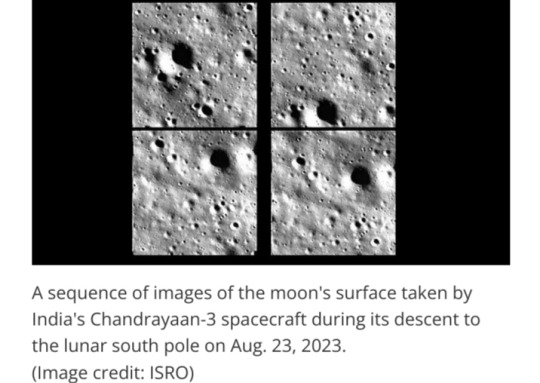
A small rover called Pragyan arrived on board Chandrayaan-3 and will soon deploy and commence its exploration of the exciting region, so many more fascinating images are likely to come soon.
Both the rover and the lander, however, are unlikely to remain operational for more than two weeks, as ISRO doesn't expect the vehicles' batteries to make it through the two-week lunar night.
Chandrayaan-3 was India's second try at landing near the moon's south pole.
The country's first attempt at a lunar touchdown, in September 2019, failed when the Chandrayaan-2 lander crashed into the moon due to a software glitch.
India's triumph comes only three days after Russia lost its Luna-25 mission, its first attempt to put a spacecraft on the moon's surface in 47 years.
Luna-25, too, was aiming for the lunar south pole but crashed into the moon instead after a botched orbital maneuver on Saturday (August 19).
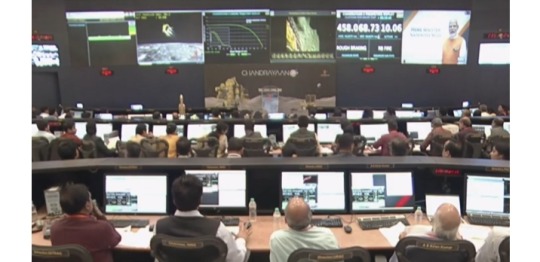


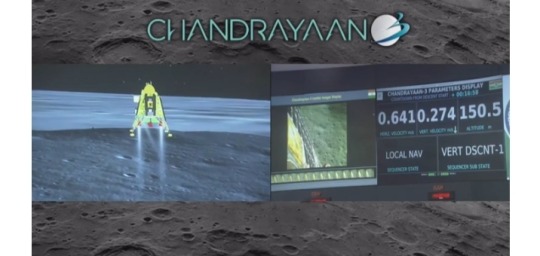

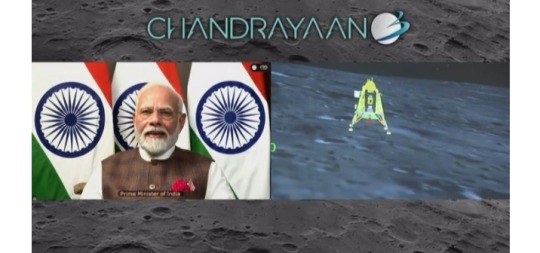
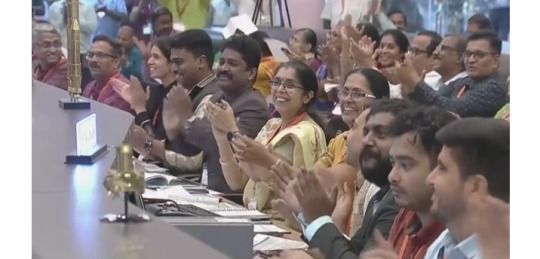
#Chandrayaan-3#Chandrayaan-3 lunar lander#Indian Space Research Organisation (ISRO)#Chandrayaan-3 spacecraft#Horizontal Velocity Camera#Landing Imager Camera#next-generation telescopes#Pragyan#India#moon#lunar landing#spacecraft#moon landing
2 notes
·
View notes
Text





🇮🇳
India Makes History, Out of 195 countries, only India has successfully landed on the Moon's south pole Chandrayaan3.
Here are the images from the Lander Horizontal Velocity Camera taken during the descent.
The image captured by the Landing Imager Camera after the landing.
It shows a portion of Chandrayaan-3's landing site. Seen also is a leg and its accompanying shadow.
Chandrayaan-3 chose a relatively flat region on the lunar surface 🙂
Source: @isro
#chandrayaan3#chandrayaan3mission#chandrayaanlaunch#moon#bharat#southernpoleofmoon#space#India#history
26 notes
·
View notes
Text
INDIA HAS JOINED THE MOON CLUB LETS GOOOOO
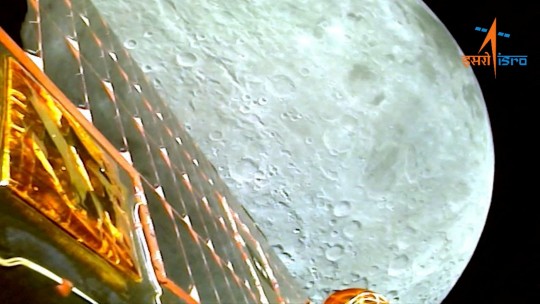
India has landed its Chandrayaan-3 spacecraft on the moon, becoming only the fourth nation ever to accomplish such a feat.
The mission could cement India’s status as a global superpower in space. Previously, only the United States, China and the former Soviet Union have completed soft landings on the lunar surface.
Chandrayaan-3’s landing site is also closer to the moon’s south pole than any other spacecraft in history has ventured. The south pole region is considered an area of key scientific and strategic interest for spacefaring nations, as scientists believe the region to be home to water ice deposits.
The water, frozen in shadowy craters, could be converted into rocket fuel or even drinking water for future crewed missions
Indian Prime Minister Narendra Modi, currently in South Africa for the BRICS Summit, watched the landing virtually and shared broadcasted remarks on the livestream.
“On this joyous occasion…I would like to address all the people of the world,” he said. “India’s successful moon mission is not just India’s alone. This is a year in which the world is witnessing India’s G20 presidency. Our approach of one Earth, one family, one future is resonating across the globe.
“This human-centric approach that we present and we represent has been welcome universally. Our moon mission is also based on the same human-centric approach,” Modi added. “Therefore, this success belongs to all of humanity, and it will help moon missions by other countries in the future.”
India’s attempt to land its spacecraft near the lunar south pole comes just days after another nation’s failed attempt to do the same. Russia’s Luna 25 spacecraft crashed into the moon on August 19 after its engines misfired, ending the country’s first lunar landing attempt in 47 years.
Chandrayaan-3’s journey
As Chandrayaan-3 approached the moon, its cameras captured photographs, including one taken on August 20 that India’s space agency shared Tuesday. The image offers a close-up of the moon’s dusty gray terrain.
India’s lunar lander consists of three parts: a lander, rover and propulsion module, which provided the spacecraft all the thrust required to traverse the 384,400-kilometer (238,855-mile) void between the moon and Earth.
The lander, called Vikram, completed the precision maneuvers required to make a soft touchdown on the lunar surface after it was ejected from the propulsion module. Tucked inside is Pragyan, a small, six-wheeled rover that will deploy from the lander by rolling down a ramp.
Vikram used its on board thrusters to carefully orient itself as it approached the lunar surface, and it slowly throttled down its engines for a touchdown just after 6 p.m. IST (8:30 a.m. ET) as applause erupted from the mission control room.
The Indian Space Research Organization, or ISRO, later confirmed it had established two-way communication with the spacecraft and shared the first images of the surface captured during the lander’s final descent.
The lander, which weighs about 1,700 kilograms (3,748 pounds), and 26-kilogram (57.3-pound) rover are packed with scientific instruments, prepared to capture data to help researchers analyze the lunar surface and deliver fresh insights into its composition.
Dr. Angela Marusiak, an assistant research professor at the University of Arizona’s Lunar and Planetary Laboratory, said she’s particularly excited that the lunar lander includes a seismometer that will attempt to detect quakes within the moon’s interior.
Studying how the moon’s inner layers move could be key information for future endeavors on the lunar surface, Marusiak said.
“You want to make sure that any potential seismic activity wouldn’t endanger any astronauts,” Marusiak said. “Or, if we were to build structures on the moon, that they would be safe from any seismic activity.”
The lander and rover are expected to function for about two weeks on the moon’s surface. The propulsion module will remain in orbit, serving as a relay point for beaming data back to Earth.
2 notes
·
View notes
Text
India's Chandrayaan-3 lunar lander barely kicked up any moon dust. Here's why that matters
The Chandrayaan 3 mission’s Vikram lander photographed on the moon’s surface by the Pragyan rover.
(Image credit: ISRO)
India’s Chandrayaan-3 spacecraft, which aced its historic landing near the moon’s south pole last August, barely kicked up any moon dust during descent thanks to a unique configuration of engines, a new study reveals. As a result, its cameras got clear views of the landing…

View On WordPress
0 notes
Text
Unlocking Lunar Mysteries: Mission Chandrayaan Reveals the Moon's Endless Enigma

Explore Chandrayaan's groundbreaking mission, uncovering the Moon's hidden secrets. From water molecules to lunar evolution, journey into lunar mysteries that defy centuries-old beliefs.
Since ancient times, the Moon has captivated people's attention, spreading its silvery shine over many civilizations, myths, and scientific pursuits. Both explorers and scientists are captivated by the moon, whether it's the romantic allure of moonlit nights or the deep mysteries concealed within its craters and valleys. In the current era of space research, Chandrayaan, India's lunar space probe, stands noteworthy for its exceptional contributions to solving lunar mysteries. This remarkable achievement also highlights the 'Make in India' initiative, emphasizing India's growing capabilities in technology and space exploration.
Khul Ke, a prominent video discussion app in India, has organized an insightful virtual group discussion on the subject matter.
Chandrayaan: A Leap into Lunar Exploration
Chandrayaan, which means "Moon Craft" in Sanskrit, symbolizes India's daring foray into space and resonates with the ‘Aatmanirbhar Bharat’ initiative, emphasizing self-reliance and innovation. The 2008 launch of Chandrayaan-1, India's first lunar probe, was the starting point for later missions. The Chandrayaan-2 mission, launched in July 2019, made substantial progress.
Peering into the Past: Discovering Lunar Evolution
A major accomplishment of Mission Chandrayaan-2 was expanding our knowledge of lunar evolution. Scientists have learned more about the moon's origin and early processes by examining its geography, mineral makeup, and geological history. The finding of water ice in the southern polar area of the moon was a game-changing discovery, upending accepted knowledge and creating new opportunities for further study and possibly, colonization.
Mapping Lunar Topography
The orbiter part of Chandrayaan-2 was crucial in producing accurate 3D maps of the moon's surface. This project has aided scientists in their understanding of the moon's geological properties and in selecting potential landing locations for the next expeditions. Planning secure lunar landings and maximizing resource use benefit greatly from these maps.
Unravelling the Moon's Water Secrets
The existence of water molecules on the moon was one of Chandrayaan-2's most astounding discoveries. This discovery dispelled ingrained notions that the moon was devoid of water. Though in trace amounts, the discovery of water molecules has significant ramifications for future lunar research, including the possibility of extracting and using these resources to support more lunar missions and space discoveries.
Cosmic Time Capsule: Studying the Moon's Surface
The surface of the moon serves as a cosmic time capsule, documenting the solar system's evolution. With the help of Chandrayaan-2's equipment, including the Dual Frequency Synthetic Aperture Radar and Terrain Mapping Camera-2, researchers have been able to dig beneath the lunar surface, revealing buried geological strata and giving insight into the moon's development over billions of years.
The Dark Side Illuminated: Shedding Light on Lunar Mysteries
The moon's near side has received much attention, but until recently, its far side was mostly unknown. Vikram's successful landing on Chandrayaan-2 close to the moon's south pole offered a rare chance to investigate this unknown region. Despite the lander's loss of communication during descent, the orbiter's instruments continued to produce useful data, providing an understanding of the makeup and properties of the lunar far side.
Prospects: Chandrayaan's Enduring Legacy
Chandrayaan's legacy is still developing as humankind's desire to explore space and find out the moon’s hidden secrets rises. The mission's accomplishments and learnings have opened the door for challenging new initiatives. India's current Chandrayaan-3 mission intends to fix Chandrayaan-2's problematic landing and advance our knowledge of lunar geology. International partnerships motivated by Chandrayaan's accomplishments also promise to advance lunar exploration.
A Global Inspiration: Collaborative Lunar Exploration
The influence of Chandrayaan transcends national boundaries. Its accomplishments have encouraged international cooperation and knowledge exchange among scientists and space organizations. By combining knowledge and resources, humanity may advance the frontiers of understanding, solving mysteries surrounding the moon and resolving issues regarding future space travel and settlement.
The Lunar Enigma Persists
The moon continues to capture our attention and inspires us to discover its mysteries with its quiet, cratered surface. We are gradually removing the layers of the lunar mystery, solving the riddle that has lingered for millennia, thanks to missions like Chandrayaan. Each discovery advances our knowledge of the moon's development, its capacity to support upcoming expeditions, and its function as a cosmic time capsule. Chandrayaan's contributions demonstrate our unquenchable interest and commitment to solving the deepest mysteries of the cosmos as humanity's space mission progresses.
0 notes
Text
Pragyan rover has done what it was expected to do: ISRO chief
Indian Space Research Organisation (ISRO) had shared a video of the Pragyan rover being rotated on the surface of the moon that was captured by a Lander Image Camera. The rover was put into sleep mode on September 2.
| Photo Credit: ANI
Chairman of the Indian Space Research Organisation (ISRO) S. Somanath on Thursday said the Pragyan rover of its moon mission Chandrayaan-3 has done what it was…

View On WordPress
0 notes
Text
The Chandrayaan-2 orbiter captured Vikram Lander from space.

🚀 Get ready for an interstellar selfie! 📸 On September 6, 2023, something truly out-of-this-world happened. The DFSAR (Dual-frequency Synthetic Aperture Radar) aboard Chandrayaan-2 captured an epic snapshot of the Chandrayaan-3 lander, and guess what? DFSAR was chilling up in space on Chandrayaan-2, not on the lander itself. It's like a space selfie from one spaceship to another! 🛰️🌌But that's not all - DFSAR is no ordinary camera. It's a SAR (Synthetic Aperture Radar) tool that shoots out microwaves (think mini radio waves) to "see" things. The coolest part? It can do this even when there's no sunlight around, like a superhero camera with X-ray vision. 🦸♂️📷
0 notes
Link
[ad_1] BENGALURU: Isro on Tuesday released an anaglyph — a simple visualisation of an object or terrain in three dimensions (3D) from stereo or multi-view images — showing Chandrayaan-3 lander Vikram on the lunar surface. Red and cyan glasses needed to view 3D effect: IsroThe anaglyph released by Isro was created using the navigation camera stereo images, which consist of both a left and right image. Isro said. The navigation camera was onboard Pragyan, the rover.“In this three-channel image, the left image is positioned in the red channel, while the right image is placed in the blue and green channels (creating cyan). The difference in perspective between these two images results in the stereo effect, which gives the visual impression of three dimensions. Red & Cyan glasses are recommended for viewing in 3D,” Isro said.Earlier in the day, scientists from Isro Telemetry, Tracking and Command Network (Istrac) successfully implemented the second Earth-bound manoeuvre of Aditya-L1 spacecraft.“Istrac/Isro ground stations at Mauritius, Bengaluru and Port Blair tracked the satellite during this operation. The new orbit attained is 282km x 40,225km,” Isro said, adding that the next manoeuvre — third of the five Earth-bound manoeuvres scheduled — is scheduled for 2.30am on September 10.On Sunday (September 3), a day after Aditya-L1 was launched on a PSLV from Sriharikota, Isro had completed the first Earth-bound manoeuvre and put the spacecraft in an orbit of 245km x 22,459km,.Aditya-L1 is a satellite dedicated to the comprehensive study of the Sun. It has seven distinct payloads — five by Isro and two by academic institutions in collaboration with Isro — developed indigenously!(function(f, b, e, v, n, t, s) ; var TimesApps = window.TimesApps; TimesApps.toiPlusEvents = function(config) var isConfigAvailable = "toiplus_site_settings" in f && "isFBCampaignActive" in f.toiplus_site_settings && "isGoogleCampaignActive" in f.toiplus_site_settings; var isPrimeUser = window.isPrime; if (isConfigAvailable && !isPrimeUser) loadGtagEvents(f.toiplus_site_settings.isGoogleCampaignActive); loadFBEvents(f.toiplus_site_settings.isFBCampaignActive); else var JarvisUrl=" window.getFromClient(JarvisUrl, function(config) if (config) loadGtagEvents(config?.isGoogleCampaignActive); loadFBEvents(config?.isFBCampaignActive); ) ; )( window, document, 'script', ); [ad_2]
0 notes
Link
Poor Russia. They can’t seem to get much right. Their most recent failure is their Luna 25 spacecraft. It was supposed to land near the Moon’s south pole but instead crashed into the surface on August 19th. Now NASA’s Lunar Reconnaissance Orbiter (LRO) has spotted Luna 25’s final resting place. Luna 25 was Russia’s first mission to the Moon in over 40 years. Roscosmos launched it into orbit on August 10th on a Soyuz 2.1b rocket from the Vostochny Cosmodrome. The launch and the travel to the Moon went well, and the spacecraft entered lunar orbit on August 16th. But, perhaps sadly, it crashed while executing a failed orbital maneuver. The Luna-25 mission lifting off from the Vostochny Cosmodrome on Aug. 11th. Credit: Roscosmos/Reuters Initially, Roscosmos announced that they’d lost contact with the spacecraft. “The measures taken on August 19 and 20 to search for the device and get into contact with it did not yield any results,” Roscosmos reported. Later, on Telegram, they said, “During the operation, an emergency situation occurred on board the automatic station, which did not allow the maneuver to be performed with the specified parameters.” Luna 25 was in a sort of race with India’s Chandrayaan-3 lunar lander. C3 was launched before L25, but Roscosmos planned for L25 to pass the Indian lander and reach the Moon’s surface first. It did reach the surface first, but only as a wreck. And as everybody knows, C3 landed successfully and is going about its business. That must sting. Artistic rendering of the Luna-25 lander on the surface of the Moon. Credit: NASA On August 21, Roscosmos revealed the likely location of L25’s impact, and NASA instructed the LRO to image the region. On August 24, the LRO captured these images and compared them to previous images of the same region pre-impact. The most recent pre-impact image is from June 2022, and a small new crater appeared sometime between the dates of the two images. The new crater is so close to the impact site that NASA confidently concluded that the new crater is indeed the impact crater created by L25’s crash. The crater is about 10 meters (33 feet) in diameter. Russia is a political pariah right now for obvious reasons. But Luna 25 was predominantly a scientific endeavour, so it’s unfortunate that the mission failed. Luna 25 carried eight science instruments, including an instrument for the spectrometry of minerals, an important part of modern lunar exploration. It was also going to measure the regolith’s thermal properties, measure plasma in the exosphere, and measure dust and micrometeorites, among other things. But that’s all gone now. Luna 25 was also going to carry a demonstration navigation camera provided by the ESA, but they pulled it after Russia invaded Ukraine. The ESA announced that they were discontinuing their participation in Luna 25, 26 and 27, saying, “As with ExoMars, the Russian aggression against Ukraine and the resulting sanctions put in place represent a fundamental change of circumstances and make it impossible for ESA to implement the planned lunar cooperation.” There’s significant schadenfreude involved in Russia’s failures right now, and that’s not likely to dissipate any time soon. That’s what happens when you invade your neighbour and do all the terrible things Russia’s done. It’s just the way it is. But Russia is a dictatorship, and while leadership might deserve to fail, this latest disappointment must be difficult for the dedicated scientists and other personnel who have no way of voicing discontent and do their work while suffering under crude leadership. There must be some people in Russia like that, right? Luna 25’s failure might not be restricted to this single mission. It was intended as a sort of test bed for subsequent landers in the Luna series. Will this failure affect future Luna missions? Russia is not exactly open about its failures. For example, when their Phobos-Grunt mission to Mars’ largest moon failed, they quickly blamed foreign sabotage. So far, they haven’t placed blame for Luna 25’s crash on anyone, but they still might. Poster art for the Russian Phobos-Grunt mission. Russia blamed foreign sabotage for the mission’s failure, with no evidence. Russian Federal Space Agency)/IKI The real problem might lie with the nature of Russian society. Rampant corruption is well-documented in Russia, and corruption tends to eat into everything. It may have played a role in Luna 25’s failure, but that’s only speculation at this point. We may never know exactly what role it might have played. For its part, NASA has avoided criticizing or condemning Russia’s latest failure. Thomas Zurbuchen, NASA’s former Associate Administrator for the Science Mission Directorate, had a conciliatory message for Roscosmos. He said on X, “Too bad to read this. None of us ever wishes bad onto other explorers. Hope this can be fixed. We are reminded that landing on any celestial object is anything but easy & straightforward. Just because others managed to do it decades ago does not guarantee success today.” Classy, diplomatic words. This latest Russian failure is just another chapter in their decline. If there’s a new space race happening between nations, Russia isn’t really participating. Prior to Luna 25’s launch, NASA Administrator Bill Nelson wished Russia well, emphasizing the cooperation between NASA and Roscosmos over the decades, pointing out that the two built the ISS together. But he also said, “I don’t think a lot of people at this point would say that Russia is actually ready to be landing cosmonauts on the Moon in the timeframe that we’re talking about going to the Moon or that China would be,” he said. The post NASA Satellite Spots the Crash Site for Luna 25 appeared first on Universe Today.
0 notes
Link
His journey on the moon began on August 24 The Indian Space Research Organization ISRO shared the latest news on how the Chandrayaan-3 mission to explore the Moon is progressing. This time, ISRO shared a video showing the maneuvers of the Pragyan rover ("knowledge", "wisdom") on the surface of the Earth's natural satellite. [caption id="attachment_50409" align="aligncenter" width="780"] Indian rover[/caption] On ISRO's Twitter blog, the mission team says: Chandrayaan 3 mission: The rover turns to look for a safe route. The rotation was captured by the lander's camera. It feels as if a child is playfully frolicking in the courtyards of Chandamama while the mother watches affectionately. Is not it? Video: Indian rover "Pragyan" frolics on the moon [caption id="attachment_50410" align="aligncenter" width="600"] Indian rover[/caption] Chandrayaan-3 is ISRO's third lunar exploration station and India's second attempt at a soft landing on the lunar surface. The first attempt was Chandrayaan-2 almost four years ago, but then the lander and rover crashed into the Moon due to a software glitch. Chandrayaan-3 successfully made a soft landing on August 23, 2023. On August 24, the journey of the Pragyan rover on the Moon began. It is planned that the lunar rover will work on the surface of the Earth's natural satellite for one lunar day (14 Earth days).
0 notes
Text
"Smile, Please!": Rover Pragyan Clicks Image Of Lander Vikram On Moon
Chandrayaan-3 rover Pragyan shared an image of the lander Vikram on Wednesday, the first that it has clicked using its Navigation camera. The picture is the first that the rover has clicked since landing on the moon. Until now, all the photos and videos had been captured by Vikram.Sharing the photograph on Twitter, Indian Space Research Organisation (ISRO) called it the “image of the…

View On WordPress
0 notes
Text

Chandrayaan-3 Mission:
The rover was rotated in search of a safe route. The rotation was captured by a Lander Imager Camera.
It feels as though a child is playfully frolicking in the yards of Chandamama, while the mother watches affectionately.
Isn't it?
Location / Source: Moon / @isroindiaofficial (IG)
1 note
·
View note
Text
"Unveiling a Lunar Delight: Chandrayaan-3 Rover's Playful Dance Resembles a Child's Fascination with 'Chandamama'"
The Indian Space Research Organisation (ISRO) has released a video footage captured by the Lander Imager Camera on August 29. The video showcases the Chandrayaan-3 rover’s intelligent maneuver on the moon, as it carefully explores different paths before selecting the safest one to proceed. This incident has evoked nostalgic memories for the space organization, comparing the rover’s rotation to a…
View On WordPress
0 notes
Text
"Smile, Please!": Rover Pragyan Clicks Image Of Lander Vikram On Moon
Chandrayaan-3 has captivated public attention since launching nearly six weeks ago in front of thousands of cheering spectators.
Chandrayaan-3 rover clicked a picture of the lander Vikram today.
New Delhi:
Chandrayaan-3 rover Pragyan shared an image of the lander Vikram on Wednesday, the first that it has clicked using its Navigation camera. The picture is the first that the rover has clicked…

View On WordPress
0 notes
Text
Why ISRO posts and delete’s picture of Chandrayaan-3 lander taken from Chandrayaan-2 orbiter, deletes tweet later
Indian Space Research Organisation (ISRO) has deleted its latest post on X wherein it released pictures of Chandrayaan-3 lander taken by Chandrayaan-2’s Orbiter minutes after posting it.
ISRO’s post which is now deleted read, “I spy you. Chandrayaan-2 Orbiter photoshoots Chandrayaan 3 lander. Chandrayaan-2’s Orbiter High-Resolution Camera (OHRC) – the came with the best resolution anyone…

View On WordPress
0 notes